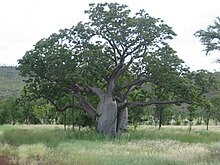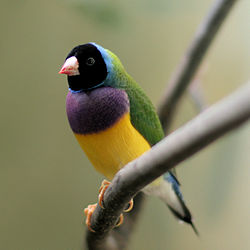Kimberley tropical savanna
| Kimberley tropical savanna | |
|---|---|
Great Sandy-Tanami desert, | |
| Geography | |
| Area | 335,299 km2 (129,460 sq mi) |
| Country | Australia |
| States | |
| Coordinates | 16°27′S 126°30′E / 16.45°S 126.5°E |
| Conservation | |
| Conservation status | Vulnerable |
| Protected | 84,546 km² (25%)[1] |
The Kimberley tropical savanna is a tropical and subtropical grasslands, savannas, and shrublands ecoregion in northwestern Australia, covering portions of Western Australia and the Northern Territory south of the Timor Sea.[2][3][4][5]
Geography
The ecoregion lies in Northwestern coastal Australia, including the Kimberley region of Western Australia and extending into the Northern Territory.
It is bounded on the north by the Timor Sea. The
Much of the ecoregion has rugged terrain of Proterozoic sandstone. The Northern Kimberley coast is generally steep with many offshore islets.
Rivers in the ecoregion include the
. Rivers and streams often follow sandstone fault blocks, eroding dramatic gorges.Some coastal areas of the Northern Kimberly are formed of basalt, and the Mitchell Plateau and Bougainville Peninsula are overlain by a layer of bauxitic duricrust.[6]
The southern Dampierland region, which includes the Dampier Peninsula and the coastal plain extending to the southwest, are on deposits of red sand. The topography of Dampierland is mostly gentle, with coastal dunes and lagoons.[6]
IBRA regions
The ecoregion includes five
Climate
The ecoregion has a
Flora

The vegetation is mostly savanna and open woodland, which vary in
Woodlands and savannas
Woodland of bloodwood eucalypts (Corymbia spp.) is widespread on sand and loam soils. Boab (Adansonia gregorii) is a distinctive woodland tree that favours sandy soils. Darwin stringybark (Eucalyptus tetrodonta) and Darwin woollybutt (E. miniata) predominate where soils are richer and rainfall is higher. The trees are evergreen and form an open canopy 5 to 15 metres high. The understory is mostly tall grass, with species of Sorghum, Heteropogon, Themeda, Chrysopogon, Aristida, and Eriachne. In parts of Northern Kimberly, the palm Livistona eastonii forms a dense sub-canopy in the woodlands.[2]
River valley lowlands with fine-textured clay and clay-loam soils are home to open woodlands characterized by trees of the genera Terminalia and Bauhinia, and grasslands of Chrysopogon, Aristida, and Dichanthium, with species of Xerochloa in wetter areas. Many of these woodlands and grasslands have been converted to farmland.[2]
Pindan
Pindan is a plant community found on the Dampier Peninsula and elsewhere the southwestern portion of the ecoregion, typically in areas with red sandy soils. Pindan is a low-canopied open woodland with trees 3 to 8 meters high. The dominant species are wattle, including Acacia eriopoda, A. tumida, A. platycarpa, and A. colei. Occasional bloodwoods emerge above the wattle canopy.[2]
Monsoon rainforests
Pockets of monsoon rainforest are found on scattered sites, generally within 150 km of the coast. There are approximately 1500 monsoon rainforest patches totaling 7,000 hectares (ha). The average patch is less than four hectares. Only 3% exceed 20 ha, and the largest is 200 ha. Monsoon rainforest is composed of semi-deciduous or deciduous trees which lose their leaves towards the end of the dry season ("raingreen"). Woody vines are common, and they climb into the tree canopies; lower-canopied monsoon rainforests are also known as monsoon vine thickets. Understory plants include low trees, shrubs and vines. Monsoon rainforest is generally fire-intolerant, in contrast to the surrounding savanna and woodlands which are adapted to frequent fires. Trees and shrubs of the monsoon rainforest often have fleshy fruits, which are eaten and dispersed by birds, bats, and mammals. Monsoon rainforests are found behind coastal dunes, on hillsides and scree slopes, at the edges of swamps and rivers, and in gorges and gullies. Rainforests have a distinct flora from the adjacent savannas and woodlands, with many ancient

In Northern Kimberley, monsoon rainforests are common on scree slopes at the bottom of escarpments, and at the edges of freshwater swamps and mangroves. They are most extensive on basalt slopes at the foot of the laterite plateaus that top the Mitchell Plateau and Bougainville Peninsula. Mixed evergreen, semi-evergreen, and deciduous trees form a canopy 15–20 meters in height, crowned by emergent trees. Monsoon rainforest trees in the Northern Kimberley include
The monsoon vine forests of the northern Dampier Peninsula grow up to 12 meters in height. Common trees include Terminalia petiolaris, mangarr (
Coastal monsoon vine thickets extend from the Dampier Peninsula as far south as Broome, in areas with 600 mm or more of annual rainfall. They are found in small, usually linear patches along the leeward side of dunes, sustained by a shallow aquifer. The endemic Cable Beach bloodwood (Corymbia paractia) is a characteristic tree, along with Goonj (Celtis philippensis), Croton habrophyllus, broad-leaved ballart (Exocarpos latifolius), karnbor (Melaleuca dealbata), marool or blackberry tree (Terminalia petiolaris), and mamajen (Mimusops elengi). Vines include Capparis lasiantha, Gymnanthera oblonga, Parsonsia kimberleyensis, stinking passionflower (Passiflora foetida), snake vine (Tinospora smilacina), and Secamone elliptica. The vine thickets often transition to pindan further inland.[6]
Riparian forests
Riparian forests line rivers and streams. Common riparian trees include river red gum (Eucalyptus camaldulensis), Terminalia platyphylla, Nauclea orientalis, Melaleuca leucadendra, and species of Ficus, Alphitonia, Calophyllum, Canarium, Cryptocarya, Myristica, and Syzygium. Understory shrubs include Pandanus aquaticus, P. spiralis, Antidesma, and Drypetes. Vines aren't as profuse as in the monsoon rainforests, but the non-native stinking passionflower is abundant in some areas. The riparian forests include many rainforest tree and shrub species with fleshy fruits. These are an important food source for wildlife, and the forests also provide habitat and shelter for many animals.[2][6]
Fauna

About 230 species of plants are endemic to the ecoregion, along with six endemic species of mammals, two endemic bird species, 31 endemic reptile species, and 16 endemic fish species.
Native mammals include the
The black grasswren (Amytornis housei) and white-quilled rock pigeon (Petrophassa albipennis) are endemic. The black grasswren lives in hummock grasslands in the sandstone hills of Northern Kimberley. The ecoregion is home to the near-threatened Gouldian finch (Erythrura gouldiae). The purple-crowned fairywren (Malurus coronatus) is threatened by habitat loss, as its riparian habitat, particularly along the Ord and Fitzroy rivers, has been trampled by cattle and converted to agriculture.[2]
The ecoregion's wetlands are important habitats for migratory and resident water birds.
The endemic lizards include seven species of
The endemic frogs include flat-headed frog (Limnodynastes depressus), cave-dwelling frog (Ranoidea cavernicola), magnificent tree frog (Ranoidea splendida), Derby toadlet (Uperoleia aspera), small toadlet (U. minima), fat toadlet (U. crassa), marbled toadlet (U. marmorata), Mjoberg's toadlet (U. mjobergi), and mole toadlet (U. talpa).
Conservation and threats

Threats to the ecoregion's wildlife include: habitat loss from converting land to agriculture and pasture; trampling and overgrazing by livestock cattle and feral cattle, donkeys, pigs, and rabbits; changes to the fire regime from replacing Aboriginal fire practices (small, frequent, and deliberately-set small fires) with widespread fire suppression resulting in larger late-season fires; and the introduction of exotic predators including house cats and foxes. Several introduced plants have become widespread weeds, displacing native plants and disrupting the region's fire and hydrologic cycles and food sources for native animals. These plants include
Protected areas

A 2017 assessment found that 84,546 km², or 25%, of the ecoregion is in protected areas but less than 10% is in IUCN Cat 1 & 2 protected areas.
References
- ^ a b Eric Dinerstein, David Olson, et al. (2017). An Ecoregion-Based Approach to Protecting Half the Terrestrial Realm, BioScience, Volume 67, Issue 6, June 2017, Pages 534–545; Supplemental material 2 table S1b. [1]
- ^ a b c d e f g h i j k "Kimberley tropical savanna". Terrestrial Ecoregions. World Wildlife Fund.
- ^ "Map of Ecoregions 2017". Resolve. Retrieved August 20, 2021.
- ^ "Kimberley tropical savanna". Digital Observatory for Protected Areas. Retrieved August 20, 2021.
- ^ "Kimberley tropical savanna". The Encyclopedia of Earth. Retrieved August 20, 2021.
- ^ a b c d e f g Kenneally, Kevin F. (2018). Kimberley Tropical Monsoon Rainforests of Western Australia: Perspectives on Biological Diversity. Journal of the Botanical Research Institute of Texas: 149 – 228. 2018.
- ^ a b UNEP-WCMC (2020). Protected Area Profile for Australia from the World Database of Protected Areas, September 2020. Available at: www.protectedplanet.net
External links
- "Kimberley tropical savanna". Terrestrial Ecoregions. World Wildlife Fund.
